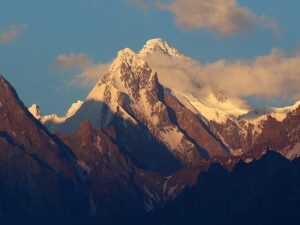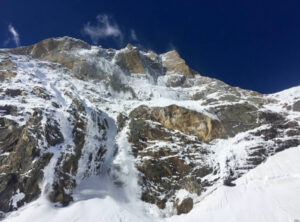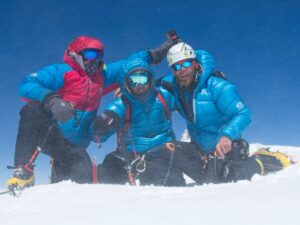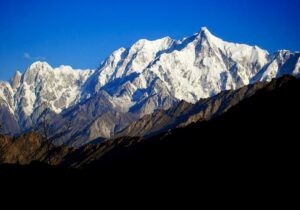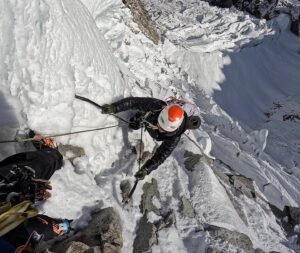Solo climbing is often associated with rock faces and is often understood as “without a rope”. Yet, not all solo climbs proceed without a rope — those that do are known as free solos — and they do not always occur on bare rock. The story of alpinism is full of references to “solo” ascents. But many alleged solos are not.
When applied to polar exploration and high altitude, the term first refers to “alone”. But a higher commitment and risk are also present.

Alex Honnold had a cameraman around him, but he was climbing free solo, without a rope.
The ultimate challenge since the 19th century
In 1858, John Tyndall wrote: “I strapped half a bottle of tea and a ham sandwich on my back, left my coat and neckcloth behind me, and in my shirt-sleeves climbed to the top of Monte Rosa alone.”
It was surely not the first solo climb in history, but a good starting point for this story. As mountaineering developed from exploration to a voluntary leisure activity, climbers on rock, ice, and mixed terrain have considered solo ascents as the epitome of risk-taking, physical and mental control, and self-confidence in one’s abilities. Solo ascents have occurred in all mountain ranges, from the north faces of the Alps to Patagonia’s Cerro Torre.
The topic is worth a book and covers some of the golden pages in mountaineering history. This piece, however, merely considers the term “solo” as it applies to high-altitude climbing. After all, being alone is a relative situation. Being alone or on one’s own is not enough to tag a climb as “solo”.

Marco Pedrini solos Cerro Torre in 1985. The photos themselves were set up and taken a few days later.
Without friends is not solo
From time to time, a social media post, press release, or interview features a climber who has “soloed” a mountain, despite the presence of a dozen others who reached the top that day.
While slightly different positions exist about what climbing solo is, there is overall agreement on what it is not, including the case cited above.

Jost Kobusch, solo on winter Everest. Photo: Jost Kobusch
A high-altitude solo ascent requires no one else on a mountain route. This includes no one from one’s own team or others, known or unknown, climbing on the same route or engaged in any other activity. Climbing Manaslu without a Sherpa, clipping and unclipping to fixed ropes is not solo.
Needless to say, the term “solo” typically applies to climbs with at least some difficulty or exposure. Hiking up a hill near home on a quiet day, without crossing paths with anyone either on the way up or down may be, strictly speaking, a solo ascent. But since it doesn’t qualify as a professional career credential, we don’t need to scrutinize it too closely.
Where does the solo climb start?
Usually, the solo climb starts and ends in Base Camp. A purist might allege that climbing partners in Base Camp might assist by giving information to the supposedly solo climber or launch a rescue if something goes wrong. For those purists, solo ascents may be only valid when the climber lacks any potential nearby assistance.
Realistically, however, being alone in an 8,000m Base Camp is hardly possible nowadays. This is not just because of the popularity of commercial climbing, but because local regulations in Nepal and Pakistan require foreign climbers to have at least a small BC crew.
That was the case with Jost Kobusch on his first winter Everest attempt. He had to keep at least a cook in BC, and there was another expedition on the mountain, albeit on a different route. On the second try, Kobusch stayed at a lodge in Lobuche. Although he did so for different reasons, it also avoided that slight taint to his solo endeavor.

Urubko faces Gasherbrum II on his solo ‘Honeymoon”‘ route, 2019.
Other climbers accept company in Base Camp but otherwise make sure that they will be isolated at least during their climb. This is why Denis Urubko left his radio behind when he launched his fast push up Gasherbrum II. He thus avoided receiving any contact or information. As well, he chose a new, direct route instead of the already fixed and packed down normal line.
Fixed ropes cannot be soloed
Overall, if someone else has previously fixed the route with ropes, a lonely climber making his way to the top when there is no one else on the 8,000m mountain isn’t really soloing. Rather, he is relying on work done by others. This is a common scenario on several peaks, where ropes remain from one year to another.
There is room for debate, however. Leftover fixed ropes do exist, and climbers can choose not to use them. Needless to say, a true solo climber wouldn’t use a tent or supplies left behind by others.
This is why the whole concept of solo climbing is so difficult on the normal routes of 8,000m or other hyper-popular peaks. Previous expeditions have always left something behind on the route.

Marc Batard, 1988.

Kobusch was photographed (but not accompanied) by Daniel Hug.
True, hard solos
The perfect solo: First ascents on hard routes
Solo climbs often occur on lower, less visited, but more difficult peaks. On these, a solo, alpine-style push on a previously unclimbed route marks the maximum expression of difficulty and commitment.
“You almost always end up carrying a much heavier backpack into the mountains than you would with a partner,” Colin Haley told Alpine Magazine. “Also, if it’s hard enough to self-belay, it becomes very slow and cumbersome compared to climbing with a partner. Not only is the climbing itself drastically more psychologically stressful, but for far-flung, expedition-style solo objectives, there is a lot of time before and after the actual ascent, hanging out by oneself, which is simply kinda boring and lonely.” Haley has soloed around 30 big routes, mainly in Alaska and Patagonia.
A good example of one of these remote solos would be the late David Lama’s ascent of Lunag Ri in 2018. He was not onsighting the route, since he had attempted the climb before with Conrad Anker, but he succeeded completely on his own. He self-belayed the most difficult sections and carried his bivy tent, plus little more than a stove and some chocolate bars. Below, some footage from the climb.

